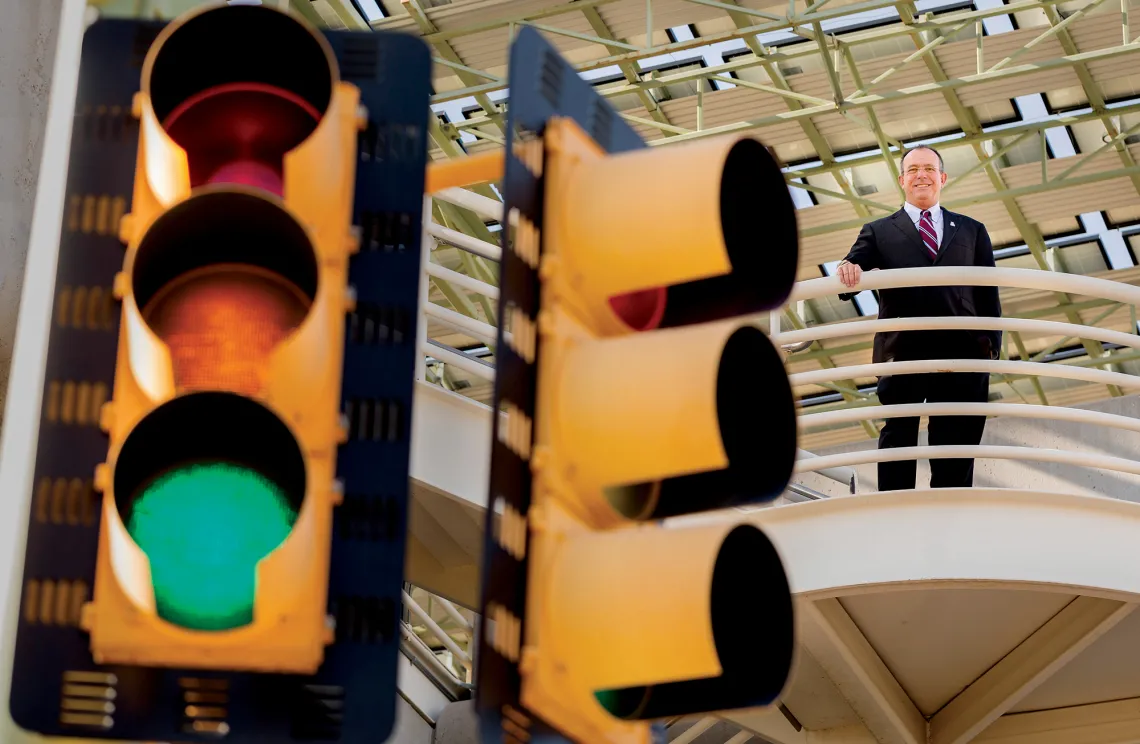An Inside Look at Next-Gen ‘Talking Cars’

One day, your car will be in a group conversation with others on the road.
No, not with other drivers, but with the cars themselves. This futuristic system’s goals include smarter traffic flow, easing congestion and, of course, a big step forward in safety.
And the University of Arizona is already making it happen on 6.5 miles of test bed — the main street of a town, called Anthem, north of Phoenix.
The Anthem site is a demonstration of how the U.S. traffic infrastructure will pool huge amounts of data, in real time, about which car is headed where and how we might adjust our driving to make it all run more smoothly.
UA engineers are helping develop these “connected vehicles” — cars that talk among themselves and with the traffic infrastructure using “smart” traffic signals.
At the UA, a team including Larry Head, the interim dean of the College of Engineering, has designed ways to make traffic signals ever more skillful as they analyze messages coming from our cars and from everything else on the road.
Much greater traffic efficiency can be achieved with data from connected vehicles, says Head.
“We can make the traffic signals — the infrastructure — intelligent. If a special vehicle, such as a fire truck, bus or freight truck, asks for special treatment, we can manipulate the signal timing to accommodate them.”
And to help the rest of us, he adds. “When not focusing on special vehicles, the system can optimize the delay and flow for regular vehicles and provide service to pedestrians.”
The technology offers real-time safety alerts and split-second updates in the form of spoken messages to drivers, flashing words on a windshield, or vibrating seats. Vehicle-to-vehicle communications, or V2V, can deliver short-range radio messages connected to braking and adaptive cruise control systems to warn a driver of an oncoming vehicle.
“The secret sauce is this: 10 times a second, your car sends and receives basic safety messages,”
Head says. “If there’s a distant siren, you know instantly where that vehicle is, and you can clear the roadway. You are never distracted by having to search around you to figure out where the siren is located.”
The UA team has helped set the standards for vehicle-to-everything communication, or V2X, for nearly 250 million U.S. cars, motorcycles, ambulances, wheelchairs and even beer trucks. In a reference to the universe of sensors and computers known as the “internet of things,”
Head says of V2X connectivity: “This is the internet of things of cars.”
Head says it all falls under the umbrella of “smart cities.”
“Everything we do at this university, smart cities integrates it,” Head says, “from engineering and law to economics and optical science to government and issues of society.”
Head’s team, in partnership with Maricopa County, is operating a demonstration of the technology in Anthem, a town of 25,000 north
of Phoenix.
They’ve put sensors and radio transmitters on top of all the traffic lights, which these days are talking with three to six test vehicles.
The test vehicles have special radios, employing a technology called Dedicated Short-Range Communications. This year, the UA will be equipping Anthem’s fire vehicles and school buses, and even some private vehicles.
Early in 2019, the UA team will have about 20 test vehicles in a system that will be operational 24/7.
So far, Head says, there’ve been no glitches. “Just excitement and anticipation of transportation in the Fourth Industrial Revolution.”
Interest in V2X is certainly not limited to the U.S. Head has demonstrated the traffic flow in Anthem to officials from Israel and Denmark. The UA works with partners at the Technical University of Munich, in Germany, where big city field tests have illustrated similar benefits.V2X will use the 5.9 GHz spectrum transportation technology that came about in 1999. It can, for example, calculate when you are likely to arrive at a stoplight — and can even change the signal timing in your favor.
In a school zone, V2X can turn on the reduced speed limit sign when kids are present — and not bother drivers at other times. On a quiet night on Tucson’s Speedway Boulevard, the green lights won’t have to change to red, ever, unless cross-traffic shows up.
Automakers are hoping a federal mandate will provide a deadline for all new cars to have V2V. One proposed U.S. federal rule called for V2V hardware in all new cars by 2023, but that’s still under negotiation.
Some are not waiting for a mandate: GM introduced the V2V-ready Cadillac CTS in 2017, and Toyota, Mercedes and Lexus are voluntarily adopting the technology.
Some European manufacturers want to wait on V2V for super-fast 5G cellular technology to reach markets. “But if we wait,” asks Head, “how many lives will be lost?”
To keep ahead of the automakers, the UA is helping to promote “smart” traffic lights with the hardware for V2X. A national program called the SPaT Challenge (the name refers to “signal phasing and timing”) encourages state and local agencies to volunteer to install traffic signal systems. Tucson and Phoenix have plans for 300 “talking cars” intersections.
All this will save time and gas — and, says Head, perhaps up to 80 percent of annual U.S. traffic deaths.
